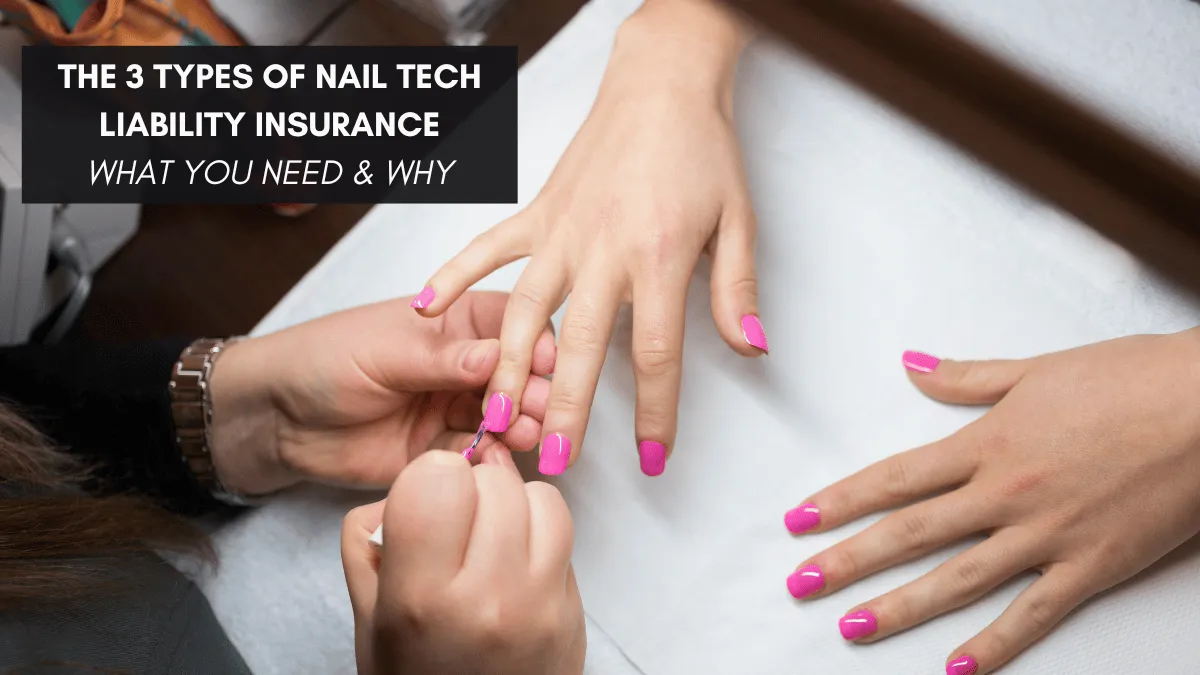Nail tech insurance discover everything you need to know about, including liability coverage, health benefits, and how to protect yourself as a nail technician.
Introduction: Nail Tech Insurance
Nail technicians are artists who bring beauty and joy to their clients through their work. However, like any profession, it comes with its risks. That’s where nail tech insurance comes into play. This comprehensive guide will explore the ins and outs of liability insurance for nail technicians, delve into the health benefits available, and provide essential tips for protecting yourself in this vibrant industry. Whether you’re considering starting a nail salon or looking to enhance your career as a nail artist, this guide has got you covered.
Understanding Nail Tech Insurance
What is Nail Tech Insurance?
Nail tech insurance is a type of liability insurance designed specifically for nail technicians and salon owners. It provides protection against claims related to the services provided, such as injuries or damages incurred by clients during their visit. This insurance is crucial for safeguarding your business and personal assets against potential lawsuits.
In a nutshell, nail tech insurance is a safety net designed especially for nail technicians and their unique risks. It generally includes two types of coverage:
- Professional Liability Insurance: This covers you if a client claims your nail services caused them bodily injury or property damage. Think allergic reactions, infections, or accidental nicks.
- General Liability Insurance: This protects you against broader accidents like a client slipping and falling in your workspace.

Why Do You Need Nail Tech Insurance?
- Lawsuits happen: Even with the best skills and precautions, accidents can occur. Insurance helps with medical bills and legal costs if a claim is made against you.
- Client peace of mind: Many clients and salons prefer insured nail techs, so it could be a requirement for jobs or renting a chair.
- Your livelihood is at stake: Uninsured liability could lead to financial ruin, potentially wiping out your business savings.
Types of Coverage
Professional Liability Insurance
This covers claims arising from the services you provide, such as a client developing an allergic reaction to the products used during a manicure.
General Liability Insurance
Also known as “slip and fall” insurance, it covers incidents that occur within your salon premises, like a client tripping over a cord and getting injured.
Product Liability Insurance
If a product you sell or use on clients causes harm, this insurance will cover the legal costs and damages.
Do Nail Techs Get Health Benefits?
While being a nail technician doesn’t automatically provide health benefits, many salon owners offer health insurance as part of their employment package. Independent contractors or self-employed nail techs can obtain health insurance through professional associations like the Associated Skin Care Professionals (ASCP) or through the marketplace.
How Much Does Nail Tech Insurance Cost?
Affordable! Most nail techs can find excellent coverage for as low as $10-$20 per month. Factors impacting pricing include your location, experience, services offered, and desired coverage limits.
Top-Rated Nail Tech Insurance Providers in the US
Here’s a quick list of popular choices:
- Insure Bodywork (https://www.insurebodywork.com/nail-tech-insurance)
- Elite Beauty Society (https://elitebeautysociety.com/nail-tech-insurance/)
- Associated Nail Professionals (ANP) (https://www.nailprofessional.com/liability-insurance)
- Beauty & Bodywork Insurance (BBI) (https://www.beautyinsuranceplus.com/nail-technicians-insurance/)
- NEXT Insurance (https://www.nextinsurance.com/business/nail-technician-insurance/)
Tip: Always compare quotes from multiple providers to find the best fit for your needs and budget.
Starting a Nail Salon Business
Is a Nail Salon a Good Business to Start?
Yes, starting a nail salon can be a lucrative venture. The beauty industry is booming, and nail services are in high demand. With the right location, skilled technicians, and effective marketing, a nail salon can become a profitable business.
How Do Nail Techs Make Money?
Nail technicians make money through various services, including manicures, pedicures, nail art, and selling nail care products. Many also rent out their space to other technicians or offer mobile services to increase their income.
Career Insights
Is Nail Artist a Good Job?
Being a nail artist is not only a creative and fulfilling job but also offers flexibility in terms of hours and work environment. It allows for continuous learning and growth within the beauty industry.
What is Nail to Nail Insurance?
Nail to nail insurance is a term sometimes used to describe comprehensive coverage for nail technicians, covering everything from the services provided to the products used.
Qualifications and Protection
Best Qualification for a Nail Technician
The best qualification for a nail technician includes certified training from a reputable beauty school, followed by obtaining a state license if required. Continuous education on the latest nail trends and techniques is also beneficial.
Protecting Yourself as a Nail Technician
To protect yourself as a nail technician, invest in comprehensive nail tech insurance, follow all health and safety guidelines, use quality products, and maintain a clean and safe work environment.
What are the benefits of ascp insurance for nail technicians?
The benefits of ASCP (Associated Skin Care Professionals) insurance for nail technicians are primarily centered around comprehensive liability coverage and additional member benefits. Here are the key benefits detailed in the search results:
- Professional & General Liability Coverage: ASCP offers significant liability coverage amounts, with policies providing $2 million per occurrence and a total of $6 million per policy year. This coverage is essential for protecting nail technicians against claims of malpractice, accidents, or injuries that could occur during their services.
- Occurrence Form Coverage: This feature ensures that even if a policy has expired, any claim filed for an incident that occurred during the active policy period will still be covered. This provides long-term security for nail technicians against potential claims.
- Portability: ASCP’s insurance policies are portable, meaning they remain in effect regardless of changes in the technician’s employment status or location. This is particularly beneficial for nail technicians who may change workplaces or move to different states.
- Additional Insureds: Nail technicians can add additional insureds to their policy, which can be crucial for those working in multiple locations or with various employers.
- Advanced Esthetics Insurance: For those who have advanced their education and offer specialized services like microblading or laser treatments, ASCP provides an option to supplement their general policy with Advanced Esthetics Insurance. This is beneficial for nail technicians who wish to expand their service offerings and require additional coverage.
- Business Personal Property (BPP) Insurance: ASCP offers an optional BPP insurance policy, which covers up to $10,000 for equipment and products, with the option to increase coverage up to $25,000. This is useful for nail technicians who have significant investments in their tools and supplies.
- Identity Theft Protection: ASCP includes identity theft protection in its insurance packages, providing an additional layer of security for nail technicians’ personal information.
- Educational Resources and Support: ASCP provides access to quality education and career support, which can be invaluable for ongoing professional development and staying updated with industry standards.
These benefits make ASCP insurance a comprehensive option for nail technicians looking for robust liability coverage and additional perks to support their professional activities and career growth.
What is the difference between general liability insurance and professional liability insurance for nail technicians?
The difference between general liability insurance and professional liability insurance for nail technicians lies primarily in the types of risks and claims each covers.
General Liability Insurance
General liability insurance for nail technicians covers claims related to physical risks and accidents that occur within the business premises or as a result of business operations. This includes:
- Bodily Injury: If a client or visitor is injured in the salon, such as through a slip-and-fall accident, general liability insurance can cover medical costs and legal fees.
- Property Damage: If the nail technician or their operations cause damage to someone else’s property, this insurance can cover the associated costs.
- Personal and Advertising Injury: This covers legal liabilities from issues like slander, libel, or copyright infringement that might occur during advertising or personal interactions within the business.
Professional Liability Insurance
Professional liability insurance, also known as errors and omissions insurance, covers risks associated with the professional services provided by the nail technician. This includes:
- Negligence or Malpractice: If a nail technician makes a professional error, such as using a product that causes an allergic reaction or damages a client’s nails, this insurance can cover the resulting financial losses and legal fees.
- Financial Harm Due to Services: This includes any financial loss a client might claim due to inadequate or incorrect services provided by the nail technician.
In summary, general liability insurance addresses more direct physical risks and damages related to the location and operations of the business, while professional liability insurance focuses on the consequences of the professional services rendered by the nail technician, particularly those leading to financial loss or harm due to errors or negligence.
What are the most common types of insurance for nail technicians?
The most common types of insurance for nail technicians include:
- General Liability Insurance: This insurance helps protect nail technicians from claims of bodily injuries, property damage, and reputational harm that might occur during their business operations.
- Professional Liability Insurance: Also known as errors and omissions insurance, this coverage protects nail technicians against claims related to negligence, incompetence, or damage that might arise from the professional services they provide.
- Product Liability Insurance: This type of insurance is crucial for nail technicians as it covers claims related to adverse reactions or injuries caused by the products used during nail services2.
These types of insurance are essential for nail technicians to manage the various risks associated with their profession and ensure financial protection against potential claims.
Conclusion:
In conclusion, navigating the world of insurance is crucial for nail technicians seeking to protect themselves and their businesses from the inherent risks of their profession. The most common types of insurance for nail technicians—general liability, professional liability, and product liability insurance—offer comprehensive coverage against a wide range of potential claims. General liability insurance covers bodily injuries, property damage, and reputational harm, while professional liability insurance addresses claims related to the professional services provided, such as negligence or malpractice. Product liability insurance is essential for covering adverse reactions or injuries caused by products used during nail services.
Understanding and securing the right mix of these insurance types can safeguard nail technicians from financial losses and legal fees associated with claims, allowing them to focus on their artistry and client satisfaction. It’s an investment in peace of mind and professional stability in the dynamic and ever-evolving beauty industry.
